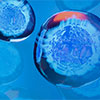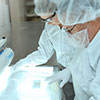chromatography+columns+HyClone+products+(Cytiva)
Catalog Number:
(10102-506)
Supplier:
Prosci
Description:
FGA is the alpha component of fibrinogen, a blood-borne glycoprotein comprised of three pairs of nonidentical polypeptide chains. Following vascular injury, fibrinogen is cleaved by thrombin to form fibrin which is the most abundant component of blood clots. In addition, various cleavage products of fibrinogen and fibrin regulate cell adhesion and spreading, display vasoconstrictor and chemotactic activities, and are mitogens for several cell types. Mutations in its gene lead to several disorders, including dysfibrinogenemia, hypofibrinogenemia, afibrinogenemia and renal amyloidosis. The protein encoded by this gene is the alpha component of fibrinogen, a blood-borne glycoprotein comprised of three pairs of nonidentical polypeptide chains. Following vascular injury, fibrinogen is cleaved by thrombin to form fibrin which is the most abundant component of blood clots. In addition, various cleavage products of fibrinogen and fibrin regulate cell adhesion and spreading, display vasoconstrictor and chemotactic activities, and are mitogens for several cell types. Mutations in this gene lead to several disorders, including dysfibrinogenemia, hypofibrinogenemia, afibrinogenemia and renal amyloidosis. Alternative splicing results in two isoforms which vary in the carboxy-terminus.
Catalog Number:
(10108-922)
Supplier:
Prosci
Description:
FADS1 is a member of the fatty acid desaturase (FADS) family. Desaturase enzymes regulate unsaturation of fatty acids through the introduction of double bonds between defined carbons of the fatty acyl chain. FADS family members are considered fusion products composed of an N-terminal cytochrome b5-like domain and a C-terminal multiple membrane-spanning desaturase portion, both of which are characterized by conserved histidine motifs.The protein encoded by this gene is a member of the fatty acid desaturase (FADS) gene family. Desaturase enzymes regulate unsaturation of fatty acids through the introduction of double bonds between defined carbons of the fatty acyl chain. FADS family members are considered fusion products composed of an N-terminal cytochrome b5-like domain and a C-terminal multiple membrane-spanning desaturase portion, both of which are characterized by conserved histidine motifs. This gene is clustered with family members FADS1 and FADS2 at 11q12-q13.1; this cluster is thought to have arisen evolutionarily from gene duplication based on its similar exon/intron organization.
Catalog Number:
(CA605-4315)
Supplier:
Rockland Immunochemical
Description:
This product has been assayed against 1.0 µg of Goat IgG in a standard capture ELISA using ABTS (2,2’-azino-bis-[3-ethylbenthiazoline-6-sulfonic acid])
Catalog Number:
(CA613-4530)
Supplier:
Rockland Immunochemical
Description:
This product has been assayed against 1.0 µg of Sheep IgG in a standard capture ELISA using pNPP p-nitrophenyl phosphate as a substrate for 30 minutes at room temperature.
Catalog Number:
(CA609-4617)
Supplier:
Rockland Immunochemical
Description:
This product has been assayed against 1.0 µg of Human IgG in a standard capture ELISA using Peroxidase Conjugated Streptavidin and ABTS (2,2’-azino-bis-[3-ethylbenthiazoline-6-sulfonic acid])
Catalog Number:
(CA612-4607)
Supplier:
Rockland Immunochemical
Description:
Anti-Rat IgM (mu chain) Antibody has been assayed against Rat IgM in a standard capture ELISA using Peroxidase Conjugated Streptavidin. A working dilution of 1:15,000 to 1:70,000 of the concentration is suggested for this product.
Catalog Number:
(CA1.00480.0100)
Catalog Number:
(10108-950)
Supplier:
Prosci
Description:
Serine palmitoyltransferase, which consists of two different subunits, is the key enzyme in sphingolipid biosynthesis. It converts L-serine and palmitoyl-CoA to 3-oxosphinganine with pyridoxal 5'-phosphate as a cofactor. SPTLC1 is the long chain base subunit 1 of serine palmitoyltransferase. Mutations in SPTLC1 gene were identified in patients with hereditary sensory neuropathy type 1.Serine palmitoyltransferase, which consists of two different subunits, is the key enzyme in sphingolipid biosynthesis. It converts L-serine and palmitoyl-CoA to 3-oxosphinganine with pyridoxal 5'-phosphate as a cofactor. The product of this gene is the long chain base subunit 1 of serine palmitoyltransferase. Mutations in this gene were identified in patients with hereditary sensory neuropathy type 1. Alternatively spliced variants encoding different isoforms have been identified.
Catalog Number:
(10108-764)
Supplier:
Prosci
Description:
ACP1 belongs to the phosphotyrosine protein phosphatase family of proteins. It functions as an acid phosphatase and a protein tyrosine phosphatase by hydrolyzing protein tyrosine phosphate to protein tyrosine and orthophosphate. This enzyme also hydrolyzes orthophosphoric monoesters to alcohol and orthophosphate.The product of this gene belongs to the phosphotyrosine protein phosphatase family of proteins. It functions as an acid phosphatase and a protein tyrosine phosphatase by hydrolyzing protein tyrosine phosphate to protein tyrosine and orthophosphate. This enzyme also hydrolyzes orthophosphoric monoesters to alcohol and orthophosphate. This gene is genetically polymorphic, and three common alleles segregating at the corresponding locus give rise to six phenotypes. Each allele appears to encode at least two electrophoretically different isozymes, Bf and Bs, which are produced in allele-specific ratios. Three transcript variants encoding distinct isoforms have been identified for this gene.
Supplier:
Analytik Jena CA
Description:
The Biometra Thermal Cycler product family offers PCR devices ranging from standard to premium equipment – all designed in line with the common principles of being reliable, easy to use, and precise.
Catalog Number:
(10108-812)
Supplier:
Prosci
Description:
There are at least four distinct but related alkaline phosphatases: intestinal, placental, placental-like, and liver/bone/kidney (tissue non-specific). The exact physiological function of the alkaline phosphatases is not known. ALPPL2 is a membrane bound glycosylated enzyme, localized to testis, thymus and certain germ cell tumors, that is closely related to both the placental and intestinal forms of alkaline phosphatase.There are at least four distinct but related alkaline phosphatases: intestinal, placental, placental-like, and liver/bone/kidney (tissue non-specific). The first three are located together on chromosome 2 while the tissue non-specific form is located on chromosome 1. The exact physiological function of the alkaline phosphatases is not known. The product of this gene is a membrane bound glycosylated enzyme, localized to testis, thymus and certain germ cell tumors, that is closely related to both the placental and intestinal forms of alkaline phosphatase.
Supplier:
LIFE TECHNOLOGIES CORP CA
Description:
The Pierce™ NAb™ Spin Kits are convenient for rapid, small-scale affinity purification of antibodies from a variety of sample types. Each pre-filled microcentrifuge spin column of the immobilized protein resin enables quick purification of 100 to 1000 µg of IgG from 25 to 500 µL of serum or other sample. The actual amount of IgG purified varies depending upon the sample type and the specific spin column used.
Catalog Number:
(CA82026-730)
Supplier:
GLOBAL LIFE SCIENCES SOLUTIONS CA
Description:
Antibiotic-Antimycotic (Pen/Strep/Fungiezone) Solution is used to control or destroy destructive microorganisms, such as gram negative, gram positive bacteria, fungi and yeast.
Catalog Number:
(10108-796)
Supplier:
Prosci
Description:
DNASE2B shares considerable sequence similarity to, and is structurally related to DNase II. The latter is a well characterized endonuclease that catalyzes DNA hydrolysis in the absence of divalent cations at acidic pH. Unlike DNase II which is ubiquitously expressed, expression of this protein is restricted to the salivary gland and lungs.The protein encoded by this gene shares considerable sequence similarity to, and is structurally related to DNase II. The latter is a well characterized endonuclease that catalyzes DNA hydrolysis in the absence of divalent cations at acidic pH. Unlike DNase II which is ubiquitously expressed, expression of this gene product is restricted to the salivary gland and lungs. The gene has been localized to chromosome 1p22.3 adjacent (and in opposite orientation) to the uricase pseudogene. Two transcript variants encoding different isoforms have been described for this gene.
Catalog Number:
(10110-554)
Supplier:
Prosci
Description:
The structure of MAS1 indicates that it belongs to the class of receptors that are coupled to GTP-binding proteins and share a conserved structural motif, which is described as a '7-transmembrane segment' following the prediction that these hydrophobic segments form membrane-spanning alpha-helices. The MAS1 protein may be a receptor that, when activated, modulates a critical component in a growth-regulating pathway to bring about oncogenic effects.The structure of the MAS1 product indicates that it belongs to the class of receptors that are coupled to GTP-binding proteins and share a conserved structural motif, which is described as a '7-transmembrane segment' following the prediction that these hydrophobic segments form membrane-spanning alpha-helices. The MAS1 protein may be a receptor that, when activated, modulates a critical component in a growth-regulating pathway to bring about oncogenic effects.
Catalog Number:
(10111-636)
Supplier:
Prosci
Description:
MGAT2 is a Golgi enzyme catalyzing an essential step in the conversion of oligomannose to complex N-glycans. The enzyme has the typical glycosyltransferase domains: a short N-terminal cytoplasmic domain, a hydrophobic non-cleavable signal-anchor domain, and a C-terminal catalytic domain. Mutations in its gene may lead to carbohydrate-deficient glycoprotein syndrome, type II.The product of this gene is a Golgi enzyme catalyzing an essential step in the conversion of oligomannose to complex N-glycans. The enzyme has the typical glycosyltransferase domains: a short N-terminal cytoplasmic domain, a hydrophobic non-cleavable signal-anchor domain, and a C-terminal catalytic domain. Mutations in this gene may lead to carbohydrate-deficient glycoprotein syndrome, type II. Two transcript variants encoding the same protein have been identified for this gene.
Inquire for Price
Stock for this item is limited, but may be available in a warehouse close to you. Please make sure that you are logged in to the site so that available stock can be displayed. If the
Stock for this item is limited, but may be available in a warehouse close to you. Please make sure that you are logged in to the site so that available stock can be displayed. If the
You must log in to order restricted items. We request that you provide the required business documentation to purchase this product for the first time.
To order chemicals, medical devices, or other restricted products please provide identification that includes your business name and shipping address via email CMD_NA@vwr.com or fax 484.881.5997 referencing your VWR account number . Acceptable forms of identification are:
-Additional Documentation May be needed to purchase this item. A VWR representative will contact you if needed.
This product has been blocked by your organization. Please contact your purchasing department for more information.
The original product is no longer available. The replacement shown is available.
This product is currently unavailable but limited stock may be available in our extended warehouse network. Please call 1-800-932-5000 and a VWR Customer Service Representative will help you.
|
|||||||||


































